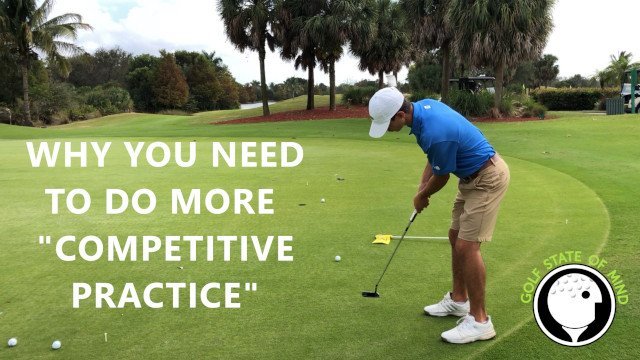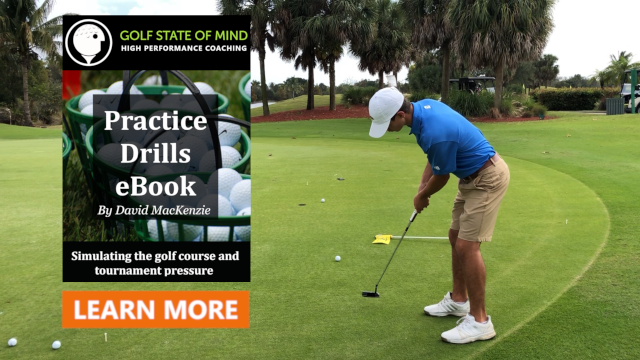
Simulation of the Golf Course
On the golf course, there are consequences (good or bad) for each shot. Also, you only have one attempt at it, so it’s important to focus fully on what you are doing. Many of us practice in a way that doesn’t train us to think, “I only have one attempt at this”. Instead it’s a feeling of “if I don’t hit this one well, I always have the next ball…”. This is something we need to change, at least during your Competitive Practice time.
Another aspect of the golf course that few of us practice for is the fact that there is at least a few minutes between each shot and the next one is always a completely different shot. Adding time between your shots during practice is something that motor learning experts call “spacing”. Make sure you take at least a minute between each shot when you are doing your Competitive Practice. Most of the games in my practice book have been designed in a way so that you are not hitting the same shot twice.
Developing a Process
One fundamental action that you can take to improve your ability to play better under pressure is by working on your “process”. When you hear me talk about “process”, I’m talking about your shot routine. That is, what you do and focus on before, during and after every shot.
Your shot routine is what anchors you to the present moment (not the future consequence of the shot), and keeps you focused on what you need to do to give yourself the best chance of a good outcome. But most golfers don’t practice this, and only think about their shot routine when they are on the course. We all connect with shots in different ways, so we need to discover what routine works for you. I’ve worked with over a thousand students over the years, and each of them have some variation on the shot routine. Some players are more visual and artistic, others more linear and technical. It’s about experimentation and finding what works.
Through applying pressure to practice (combined with our playing experiences) we can work on a process which improves our ability to play our best golf under pressure.
A good portion of my practice book contains “Competitive Practice drills”, designed to help improve and hone your process.
Practicing lowering the “Stress Response”
When you’re nervous, certain changes occur in your body and mind. You get tense and your ability to focus diminishes. As a result, there is less intent for the shot and your movement is not as fluid.
If you’ve read my Ultimate Mental Game Training System, you’ll know the causes and effects of performance anxiety on the golf course. It’s important to learn how to reduce the stress response, so that we can access our best skills under pressure.
Practicing the use of stress management techniques (such as good breathing techniques) and developing a robust process that you follow on the course is essential. But developing these skills requires practice in a pressurized environment, which is what you’ll achieve through Competitive Practice. You need to practice how to become more comfortable, being uncomfortable.
Testing Yourself and Improving Your Weaknesses
Pressure exacerbates our weaknesses. It’s why playing under pressure is a win-win. By succeeding in it we gain a huge sense of accomplishment and a boost of confidence, but failing in it also tells us a lot about our weaknesses and our tendencies under pressure.
Using feedback from your rounds is important in this, which is why many of my students keep a performance journal to reflect and determine what they can do better, and refine their process and practice.
Competitive Practice also give us the opportunity to test what we’ve been working on with our technical practice. Let’s say that you’re working on your putting distance control for lag putting and you’ve made some changes to your setup and stroke. After some random putting drills, you will want to apply pressure to test it. It’s better to test it in practice, than it is on the course!
Adding Consequences and Raising “Intensity”
In order for you to get the feeling of being accountable for every shot, like you are on the course, we need consequences during our Competitive Practice. We want to build frustration and create pressure, so you practice being nervous and uncomfortable and most of all, simulate the golf course.
The Competitive Practice drills I have in my practice book all have a “pass rate” to complete a challenge (which depends on your skill level) and that in itself will add pressure and frustration. You can keep track of your scores and try to complete them with a higher score or fewer attempts next time. However, there are additional ways that you can increase “intensity” further to experience more of what you do when you’re in a tournament.
A good way to increase intensity is to deliberately increase your heart rate. The first sign of nervousness is an increased heart rate, so if you can learn how play shots with a higher heart rate, you’re going to learn how to play when you’re feeling the effects of pressure on the course.
To get your heart rate up, try running on the spot or doing short sprints before and in between playing shots. Use controlled breathing to lower it to your optimal intensity level.
You can also add more pressure to the drills by adding consequences such as:
- 20 push-ups
- Running laps around the practice area
- Loss of a bet with your practice partners
- Hole at least one bunker shot
- Hole 10 consecutive 5ft putts
So what specific drills can you do to create the pressurized playing environment, so you can develop these skills? Please check out my Golf State of Mind Practice Book, which contains over 70 Random and Competitive Practice Drills.
